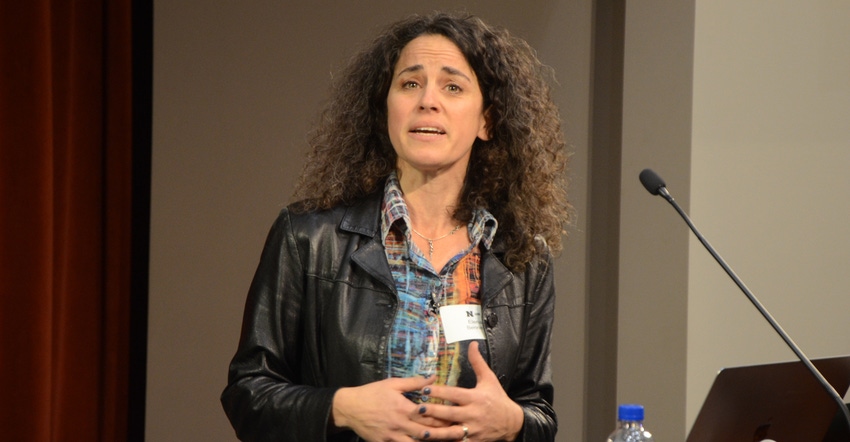
Compared to the timeline of the planet itself, or even human society, our own lifetime is a mere blip. The past 11,700 years, otherwise known as the Holocene, encompass all of contemporary human society, and directly related, all of agricultural production.
While not an official geological epoch, the Anthropocene, the name some scholars use to denote the current era, marks a number of changes in society, ecosystems and modern agricultural landscapes.
At a recent Heuermann Lecture at the University of Nebraska-Lincoln, Elena Bennett, associate professor at McGill University in Quebec, discussed challenges and opportunities for maintaining the long-term resilience of society and agriculture through the next 10,000 years in the current era.
Be forewarned — this probably isn't a discussion for armchair experts looking for an argument over the validity of climate science, but for those open to a different perspective who recognize the need to adapt to a changing climate and an overall changing agricultural landscape.
Bennett defines resilience as the extent to which a system can develop with change, by withstanding disturbances, coping with uncertainty and risk, and still sustaining key properties — in other words, maintaining the capacity to produce ag products and sustain rural livelihoods and communities.
"In many cases, what we've done is we've grown a system that focuses on shorter-term stability over long-term resilience," Bennett said.
Shift in production
It goes without saying that, over time, yields have significantly increased in crops produced around the world. For example, average yields for corn produced in the U.S. rose from 28 bushels per acre in 1900 to 176 bushels per acre in 2017, according to USDA National Agricultural Statistics Service data.
While beneficial for overall productivity, those yield increases have been accompanied by simplified, intensified production with less diversity in the types of crops or livestock grown, Bennett said.
Simplified, monocultural production systems are more sensitive to pests, sudden changes in demand, widespread drought and other climate events, Bennett said. They also require more synthetic inputs and capital investment to maintain short-term stability. Overreliance on capital and input investment is what Bennett calls coerced resilience, which masks the issue of lost natural resources.
"What we typically see in systems that are in this coerced resilience state is there is a continual increase in the need to compensate over time," she said. "So we need to add more and more into the system. And that means that we're relying on outside systems we can't control."
So, what might resilient agriculture look like? It could be anything that has the capacity to tolerate change without shifting into a qualitatively different state. From Bennett's standpoint, this involves shifting from a mindset of optimized production relative to economic costs to one of optimizing production relative to environmental costs.
"In order to do that, we need to start to focus on all of the benefits that are provided by agricultural systems, and not just the food that's being provided, and not just the environmental benefits that are being provided," she said.
Ecosystem services
Bennett encourages looking at ecosystems from a comprehensive perspective by identifying the services a given ecosystem provides.
For example, a soybean field provides the service of agricultural production. However, it also may have buffer strips or prairie strips within or around its borders, as well as adjacent woodlands. These buffers and woodlands provide services such as carbon sequestration and runoff reduction, as well as wildlife habitat and recreation for hunters.
If the farmer seeds cover crops after harvest, those cover crops provide services such as reduced erosion, building soil organic matter and an opportunity to use the cover crop as forage for livestock.
Bennett explained some services are synergistic while others are antagonistic to each other, meaning they aren't very compatible. For example, prairie strips are compatible with services such as outdoor recreation and carbon sequestration.
However, as prairie or woodlands are converted to cropland, those services become less available. Meanwhile, intensive production that isn't diverse — such as a single- or two-year crop rotation without cover crops — is less compatible with other services.
"Agriculture is not resilient if it is financially profitable but undermining diversity," Bennett said. "If it's producing food, but is not economically viable in any local community setting, that's also not resilient. If we're causing long-term or widespread environmental crises, it's not resilient no matter how economically successful it is or how much food is being produced. Just having a marginally greener revolution with incremental increases in efficiency is really unlikely to be enough."
Instead, Bennett recommends large, systematic changes, experimentation, and institutional changes that give farmers enough protection to experiment.
"Building resilient agriculture for the next 10,000 years, we're going to have to resist focusing on single solutions to near-term problems, but instead move toward experimentation, diversity of solutions that really allow for adaptation and exploration," she said.
About the Author(s)
You May Also Like






